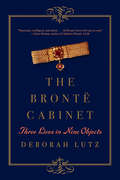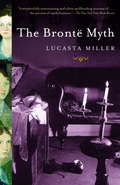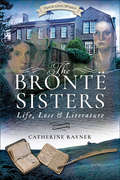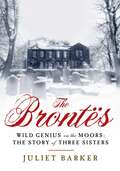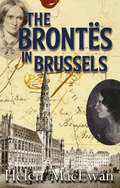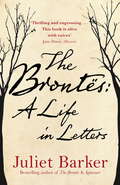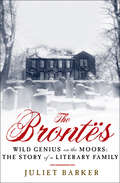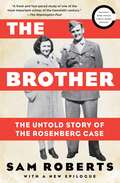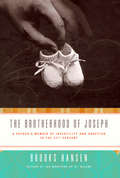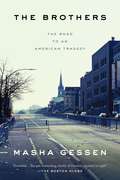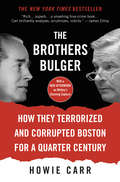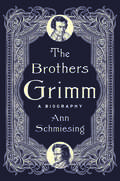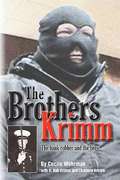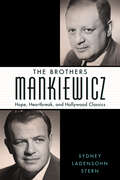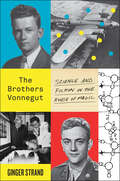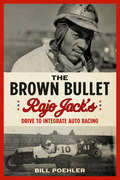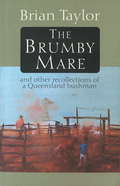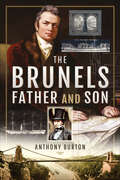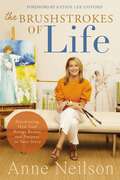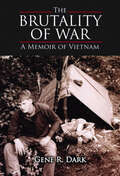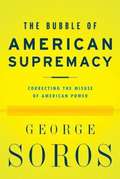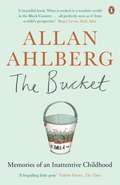- Table View
- List View
The Brontë Cabinet: Three Lives in Nine Objects
by Deborah LutzAn intimate portrait of the lives and writings of the Brontë sisters, drawn from the objects they possessed. In this unique and lovingly detailed biography of a literary family that has enthralled readers for nearly two centuries, Victorian literature scholar Deborah Lutz illuminates the complex and fascinating lives of the Brontës through the things they wore, stitched, wrote on, and inscribed. By unfolding the histories of the meaningful objects in their family home in Haworth, Lutz immerses readers in a nuanced re-creation of the sisters' daily lives while moving us chronologically forward through the major biographical events: the death of their mother and two sisters, the imaginary kingdoms of their childhood writing, their time as governesses, and their determined efforts to make a mark on the literary world. From the miniature books they made as children to the blackthorn walking sticks they carried on solitary hikes on the moors, each personal possession opens a window onto the sisters' world, their beloved fiction, and the Victorian era. A description of the brass collar worn by Emily's bull mastiff, Keeper, leads to a series of entertaining anecdotes about the influence of the family's dogs on their writing and about the relationship of Victorians to their pets in general. The sisters' portable writing desks prove to have played a crucial role in their writing lives: it was Charlotte's snooping in Emily's desk that led to the sisters' first publication in print, followed later by the publication of Jane Eyre and Wuthering Heights. Charlotte's letters provide insight into her relationships, both innocent and illicit, including her relationship with the older professor to whom she wrote passionately. And the bracelet Charlotte had made of Anne and Emily's intertwined hair bears witness to her profound grief after their deaths. Lutz captivatingly shows the Brontës anew by bringing us deep inside the physical world in which they lived and from which their writings took inspiration.
The Brontë Myth
by Lucasta MillerSince 1857, hardly a year has gone by without a book or play or monograph or film about the Brontës. Each generation has reimagined Charlotte, Emily, and Anne in ways that reflect changing visions--of the role of the woman writer or of sexuality or of the very concept of personality. Charlotte Brontë has been seen as domestic saint, as sex-starved hysteric, as ambitious literary careerist. Her sister Emily has been furnished with apocryphal lovers of both sexes; has even been denied the authorship of Wuthering Heights by conspiracy theorists who attribute it to her brother, Branwell. Now Lucasta Miller, in The Brontë Myth, shows us how the Brontës became cultural symbols almost as soon as their novels were published; how they became notorious even before the veil dropped from their carefully chosen pseudonyms, as Charlotte's Jane Eyre and Emily's Wuthering Heights, appearing out of nowhere, instantly fascinated, inspired, and scandalized English readers. The subsequent discovery that Currer, Ellis, and Acton Bell were three youngish spinsters-- parson's daughters--living rural lives of utmost propriety made interest in the sisters obsessive. Add a supposedly ferocious father and untimely death, to say nothing of the Victorian penchant for seeing noble sacrifice in every possible situation, and the production of legends multiplied. Lucasta Miller provides fascinating insight into the manufacture of cultural myth and how it can distort our memory of the artist even as it obscures the art. She traces the reinterpretations, indeed re-creations, of the Brontës, from Charlotte's own efforts to soften her dead sisters' reputations and Mrs. Gaskell's classic portrait of the artists as exemplary Christian ladies to the fashionably Freudian psychobiographies of the 1920s and '30s, from counterfeit memorabilia and the promotion of literary tourism to Hollywood representations of gloomy heroines on savage windswept moors. She rescues the Brontës from their admirers and attackers, giving us back three vivid women who, with little formal education, were writing in the days when few women dared to try: geniuses and sisters who, in the words of a household witness in the late 1850s, were "as cheerful and full of spirits as possible. ... full of fun and merriment. "
The Brontë Sisters: Life, Loss and Literature
by Catherine RaynerJane Eyre, Wuthering Heights, The Tenant of Wildfell Hall... these fictional masterpieces are all recognized as landmarks of English Literature. Still inspirational and challenging to readers today, upon release in the mid-nineteenth century they caused a veritable sensation, chiefly due to their subject matter and unconventional styles. But the greatest sensation of all came when these books were revealed to be the creations of women. This is the story of those women and of the forces that shaped them into trailblazing writers.From early childhood, literature and the world of books held the attention and sparked the fertile imaginations of the emotionally intense and fascinating Bronte siblings. Beset by tragedy, three outlets existed for their grief and their creative talents; they escaped into books, into the wild moorlands surrounding their home and into their own rich inner lives and an intricate play-world born of their collective imaginations.In this new study, Catherine Rayner offers a full and fascinating exploration of the formative years of these bright children, taking us on a journey from their earliest years to their tragically early deaths. The Bronte girls grew into women who were unafraid to write themselves into territories previously only visited by male authors. In addition, they tackled all the taboo subjects of their time; divorce, child abuse, bigamy, domestic violence, class, female depression and mental illness. Nothing was beyond their scope and it is especially for this ability and determination to speak for women, the marginalized and the disadvantaged that they are remembered and celebrated today, two hundred years after their births in the quiet Yorkshire village of Haworth.This timely release offers a fresh perspective on a fascinating family and a unique trio of talented and trailblazing sisters whose books will doubtless continue to haunt and inspire for generations to come.
The Brontës
by Juliet BarkerThe story of the tragic Brontë family is familiar to everyone: we all know about the half-mad, repressive father, the drunken, drug-addled wastrel of a brother, wildly romantic Emily, unrequited Anne, and "poor Charlotte." Or do we? These stereotypes of the popular imagination are precisely that - imaginary - created by amateur biographers such as Mrs. Gaskell who were primarily novelists and were attracted by the tale of an apparently doomed family of genius. Juliet Barker's landmark book is the first definitive history of the Brontës. It demolishes the myths, yet provides startling new information that is just as compelling - but true. Based on first-hand research among all the Brontë manuscripts, including contemporary historical documents never before used by Brontë biographers, this book is both scholarly and compulsively readable. The Brontës is a revolutionary picture of the world's favorite literary family.
The Brontës in Brussels
by Helen MacewanA fascinating and thorough account of Charlotte and Emily Brontë's formative stay in Brussels during 1842-43The Brontës' time in Belgium, five years before they became best-selling authors, is the least-known episode of their lives, but is a fascinating and important one. The book follows in the tracks of the sisters in Brussels, describing their life in the city: though the school where they came to study French has now disappeared, there is still a lot to be seen of the city the sisters knew; two of Charlotte's four novels (Villette and The Professor) are also based on her spell abroad, which was pivotal to her both as a writer and personally, since she fell in love with her teacher Constantin Heger. Charlotte's moving and harrowing letters to Heger--a respectable married man--are reproduced in full here and belie the common image of her as the motherly and strait-laced Brontë. Also including maps of the period, extracts from Villette reflecting real-life experiences in Brussels and translations of the sisters' little-known "Belgian essays," what emerges is a complete portrait of a slice of literary history--as well as a haunting evocation of a time and a place that came to haunt the Brontës themselves.
The Brontës in Context
by Marianne ThormählenVery few families produce one outstanding writer. The Brontë family produced three. The works of Charlotte, Emily and Anne remain immensely popular, and are increasingly being studied in relation to the surroundings and wider context that formed them. The forty-two new essays in this book tell 'the Brontë story' as it has never been told before, drawing on the latest research and the best available scholarship while offering new perspectives on the writings of the sisters. A section on Brontë criticism traces their reception to the present day. The works of the sisters are explored in the context of social, political and cultural developments in early-nineteenth-century Britain, with attention given to religion, education, art, print culture, agriculture, law and medicine. Crammed with information, The Brontës in Context shows how the Brontës' fiction interacts with the spirit of the time, suggesting reasons for its enduring fascination.
The Brontës: A Life In Letters
by Juliet BarkerThe Brontë story has been written many times but rarely as compellingly as by the Brontës themselves. In this selection of letters and autobiographical fragments we hear the authentic voices of the three novelist sisters, Charlotte, Emily and Anne, their brother, Branwell, and their father, the Reverend Patrick Brontë. We share in their progress over the years: the exuberant childhood, absorbed in wild, imaginative games; the years of struggling to earn a living in uncongenial occupations before Jane Eyre, Wuthering Heights and The Tenant of Wildfell Hall took the literary world by storm; the terrible marring of that success as, one by one, Branwell, Emily and Anne died tragically young; the final years as Charlotte, battling against grief, loneliness and ill health, emerged from anonymity to take her place in London literary society and, finally, found an all too brief happiness in marriage to her father's curate. Juliet Barker, author of the highly acclaimed biography The Brontës has used her unrivalled knowledge of the family to select extracts from letters and manuscripts, many of which are appearing here in print for the first time. Charlotte was a letter-writer of supreme ability, ranging from facetious notes and homely gossip to carefully composed pages of literary criticism and, most movingly of all, elegiac tributes to her beloved brother and sisters. Emily and Anne remain tantalizingly evasive. Very few of their letters are extant. Emily's are mere businesslike notes, though these have been supplemented by her more revealing diary papers; Anne's letters are equally frustrating, but only because their quality makes us regret their paucity.Branwell emerges as distinctly as Charlotte from his letters. Whether trying to impress William Wordsworth with his literary abilities, showing off to his artistic friends or finally coming to terms with a life of failed ambition, his character is laid bare on every page. The Reverend Patrick Brontë's devotion to his children and passionate advocacy of liberal causes are equally well illustrated in what can only be a small selection from his voluminous correspondence.The Brontë letters are supplemented by extracts from other contemporary sources, which allow us to see the family as their friends and acquaintances saw them. A brief narrative text guides the reader through the letters and sets them in context. By allowing the Brontës to tell their own story, Juliet Barker has not only produced an innovative form of biography but also given us the unique privilege of participating intimately in the lives of one of the most famous and best-loved families of English literature.
The Brontës: A Life In Letters
by Juliet BarkerThe Brontë story has been written many times but rarely as compellingly as by the Brontës themselves. In this selection of letters and autobiographical fragments we hear the authentic voices of the three novelist sisters, Charlotte, Emily and Anne, their brother, Branwell, and their father, the Reverend Patrick Brontë. We share in their progress over the years: the exuberant childhood, absorbed in wild, imaginative games; the years of struggling to earn a living in uncongenial occupations before Jane Eyre, Wuthering Heights and The Tenant of Wildfell Hall took the literary world by storm; the terrible marring of that success as, one by one, Branwell, Emily and Anne died tragically young; the final years as Charlotte, battling against grief, loneliness and ill health, emerged from anonymity to take her place in London literary society and, finally, found an all too brief happiness in marriage to her father's curate. Juliet Barker, author of the highly acclaimed biography The Brontës has used her unrivalled knowledge of the family to select extracts from letters and manuscripts, many of which are appearing here in print for the first time. Charlotte was a letter-writer of supreme ability, ranging from facetious notes and homely gossip to carefully composed pages of literary criticism and, most movingly of all, elegiac tributes to her beloved brother and sisters. Emily and Anne remain tantalizingly evasive. Very few of their letters are extant. Emily's are mere businesslike notes, though these have been supplemented by her more revealing diary papers; Anne's letters are equally frustrating, but only because their quality makes us regret their paucity.Branwell emerges as distinctly as Charlotte from his letters. Whether trying to impress William Wordsworth with his literary abilities, showing off to his artistic friends or finally coming to terms with a life of failed ambition, his character is laid bare on every page. The Reverend Patrick Brontë's devotion to his children and passionate advocacy of liberal causes are equally well illustrated in what can only be a small selection from his voluminous correspondence.The Brontë letters are supplemented by extracts from other contemporary sources, which allow us to see the family as their friends and acquaintances saw them. A brief narrative text guides the reader through the letters and sets them in context. By allowing the Brontës to tell their own story, Juliet Barker has not only produced an innovative form of biography but also given us the unique privilege of participating intimately in the lives of one of the most famous and best-loved families of English literature.
The Brontës: The Fantastically Feminist (and Totally True) Story of the Astonishing Authors
by Anna DohertyAn inspiring, empowering, fantastically feminist and totally true story, perfect for fans of Little People, Big Dreams and Goodnight Stories for Rebel Girls! Meet the incredible Brontë family - Charlotte, Emily, Anne and Branwell Brontë are no ordinary children. Growing up on the wild, lonely moors of Yorkshire, they have nothing to entertain them but their imaginations and each other. So they invent extraordinary imaginery worlds, full of wars and love stories, soldiers, heroes and villains, ruled over by powerful women. As they grow up, the Brontës discover that the real world isn't such a great place to be a girl. But they are so determined that their voices be heard, they overcome almost unbeatable odds to be bestselling authors. This is the absolutely astonishing, fantastically feminist and, best of all, totally true story of one amazing family!
The Brontës: Wild Genius on the Moors: The Story of a Literary Family
by Juliet BarkerIn a revised and updated edition, the real story of the Brontë sisters, by distinguished scholar and historian Juliet Barker The story of the tragic Brontë family is familiar to everyone: we all know about the half-mad, repressive father, the drunken, drug-addicted wastrel of a brother, wildly romantic Emily, unrequited Anne, and "poor Charlotte." Or do we? These stereotypes of the popular imagination are precisely that--imaginary--created by amateur biographers like Elizabeth Gaskell who were primarily novelists and were attracted by the tale of an apparently doomed family of genius. Juliet Barker's landmark book is the first definitive history of the Brontës. It demolishes the myths, yet provides startling new information that is just as compelling--but true. Based on firsthand research among all the Brontë manuscripts and among contemporary historical documents never before used by Brontë biographers, this book is both scholarly and compulsively readable. The Brontës is a revolutionary picture of the world's favorite literary family.
The Brother: The Untold Story of the Rosenberg Case
by Sam Roberts“A fresh and fast-paced study of one of the most important crimes of the twentieth century” (The Washington Post), The Brother now discloses new information revealed since the original publication in 2003—including an admission by his sons that Julius Rosenberg was indeed a Soviet spy and a confession to the author by the Rosenbergs’ co-defendant.Sixty years after their execution in June 1953 for conspiring to steal atomic secrets, Julius and Ethel Rosenberg remain the subjects of great emotional debate and acrimony. The man whose testimony almost single-handedly convicted them was Ethel Rosenberg’s own brother, David Greenglass. Though the Rosenbergs were executed, Greenglass served a mere ten years in prison, after which, with a new name, he disappeared. But journalist Sam Roberts found Greenglass, and then managed to convince him to talk about everything that had happened. Since the original publication of The Brother, Roberts sued to release grand jury testimony, which further implicates Greenglass and demonstrates how the prosecution was tainted. One of the defendants, Morton Sobell, admitted to Roberts that he and Julius Rosenberg were spies. Furthermore, Michael and Robert Meeropol, the Rosenbergs’ sons, acknowledged to Roberts that although their mother was not legally culpable, that the “secret” to the atomic bomb was not compromised, and that the death penalty was excessive, their father was, in fact, guilty of conspiracy to commit espionage on behalf of the Soviet Union. Now released with this important new information, The Brother is more than ever, “A gripping account of the most famous espionage case in US history…an excellent book, written with flair and alive with the agony of the age” (The Wall Street Journal).
The Brotherhood of Joseph: A Father's Memoir of Infertility and Adoption in the 21st Century
by Brooks HansenWhile miracles in reproductive technology have brought joy to millions, those very advances have plunged many couples into an unrelenting cycle of hope and heartbreak. One failed attempt may lead to another and another—but how do you give up when there is always another doctor, another procedure holding out the possibility of conception and the child you yearn for? Brooks Hansen vividly captures the emotional turmoil he and his wife, Elizabeth, endured as they tried to conceive, the years their lives were put on hold, and the excruciating sense of loss. He writes too of the couple's journey through the bewildering world of adoption—a path to parenthood fraught with financial, legal, and emotional risks of its own. Offering men a chance to be heard and women a rare opportunity to view the struggle with infertility from a male perspective, The Brotherhood of Joseph brings to life the anger, frustration, humor, heartbreak, and sense of helplessness that come to dominate the husband's role. As his remarkable account reaches its finale in Siberia, however, Hansen's once again becomes the story of a husband and a wife who, even after years of medical frustration and fruitless paperwork, still must take one last risk together and trust in their most basic instincts before their new family can be born. "Literary grace that has the remarkable power to act as a lens" is how the New York Times Book Review has described Hansen's writing, and that grace has never been more evident than in this remarkable memoir.
The Brothers
by Masha GessenAn important story for our era: How the American Dream went wrong for two immigrants, and the nightmare that resulted. On April 15, 2013, two homemade bombs exploded near the finish line of the Boston marathon, killing three people and wounding more than 264 others. In the ensuing manhunt, Tamerlan Tsarnaev died, and his younger brother, Dzhokhar, was captured and ultimately charged on thirty federal counts. Yet long after the bombings and the terror they sowed, after all the testimony and debate, what we still haven't learned is why. Why did the American Dream go so wrong for two immigrants? How did such a nightmare come to pass?Acclaimed Russian-American journalist Masha Gessen is uniquely endowed with the background, access, and talents to tell the full story. An immigrant herself, who came to the Boston area with her family as a teenager, she returned to the former Soviet Union in her early twenties and covered firsthand the transformations that were wracking her homeland and its neighboring regions. It is there that the history of the Tsarnaev brothers truly begins, as descendants of ethnic Chechens deported to Central Asia in the Stalin era. Gessen follows the family in their futile attempts to make a life for themselves in one war-torn locale after another and then, as new émigrés, in the looking-glass, utterly disorienting world of Cambridge, Massachusetts. Most crucially, she reconstructs the struggle between assimilation and alienation that ensued for each of the brothers, incubating a deadly sense of mission. And she traces how such a split in identity can fuel the metamorphosis into a new breed of homegrown terrorist, with feet on American soil but sense of self elsewhere.From the Hardcover edition.
The Brothers Bulger: How They Terrorized and Corrupted Boston for a Quarter Century
by Howie CarrIn this riveting "New York Times" bestseller, award-winning columnist Howie Carr reveals for the first time the true lives and dark deeds of two of Boston's most infamous sons in one of the most compelling real-life family sagas of modern times.
The Brothers Grimm: A Biography
by Ann SchmiesingThe first English-language biography in over fifty years to tell the full, vibrant story of Jacob and Wilhelm Grimm, known to history as the Brothers Grimm &“Ann Schmiesing . . has brought the brothers to life in their fullness.&”—Dominic Green, Wall Street Journal &“Magisterial.&”—Kirkus Reviews More than two hundred years ago, the German brothers Jacob Grimm (1785–1863) and Wilhelm Grimm (1786–1859) published a collection of fairy tales that remains famous the world over. It has been translated into some 170 languages—more than any other German book—and the Brothers Grimm are among the top dozen most translated authors in the world. In addition to collecting tales, the Grimms were mythographers, linguists, librarians, civil servants, and above all the closest of brothers, but until now, the full story of their lifelong endeavor to preserve and articulate a German cultural identity has not been well known. Drawing on deep archival research and decades of scholarship, Ann Schmiesing tells the affecting story of how the Grimms&’ ambitious projects gave the brothers a sense of self-preservation through the atrocities of the Napoleonic Wars and a series of personal losses. They produced a vast corpus of work on mythology and medieval literature, embarked on a monumental German dictionary project, and broke scholarly ground with Jacob&’s linguistic discovery known as Grimm&’s Law. Setting their story against a rich historical backdrop, Schmiesing offers a fresh consideration of the profound and yet complicated legacy of the Brothers Grimm.
The Brothers Krimm: The Bank Robber and the Hero
by Cecile Wehrman H. Krimm Charlene KrimmOn September 14, 2009, a serial bank bandit scores one of his biggest hauls ever in Williston, N. D. Jimmy Krimm has been robbing banks for most of his adult life, but the biggest crime he ever committed took place before he left his mother's Michigan home decades earlier. When police deliver the news that her oldest son is dead, Charlene Krimm is left pining for any children he may have fathered, and with the task of breaking the news to her younger son, Rob -- Jimmy's first victim. "The Brothers Krimm" examines the way childhood sexual abuse forms two men --turning one into a predator -- and the other into the kind of hero whose triumph is found in his will to rise above the past. In the wake of the events of September 14, 2009, a small town reporter is compelled to dig deeper into the mystery of Jimmy Krimm. Driven by the desire to help his family gain closure, Cecile Wehrman sets out to follow the trail of a serial bank robber -- a trail that leads, inexplicably, to her own doorstep - to the abuse in her own past, and to the very real possibility she could have been Jimmy's next victim. From Chapter 1: "It's a story that will test all of my skills as a researcher. I will have to examine my ethics as a journalist. I will have to open old wounds, personal wounds. My faith will be shaken. Inconsequential things, something as simple as finding a penny, will take on new meaning. . . And it won't be until many months into it that my research will uncover an inexplicable connection to this robber -- this man who terrorized my neighborhood. It is a piece of evidence so startling it will literally knock me to the ground. "With the cooperation of the Krimm family, through prison documents, police records and even Jimmy's own words and photos from the road during his final bank robbing spree, Wehrman chronicles the exploits of a modern day Jesse James - dispelling forever the notion of the dashing bank bandit and replacing it with the portrait of a homeless wanderer who took what he needed, no matter who it hurt.
The Brothers Mankiewicz: Hope, Heartbreak, and Hollywood Classics (Hollywood Legends Series)
by Sydney Ladensohn SternWinner of the 2020 Peter C. Rollins Book AwardLonglisted for the 2020 Moving Image Book Award by the Kraszna-Krausz FoundationNamed a 2019 Richard Wall Memorial Award Finalist by the Theatre Library AssociationHerman J. (1897–1953) and Joseph L. Mankiewicz (1909–1993) wrote, produced, and directed over 150 pictures. With Orson Welles, Herman wrote the screenplay for Citizen Kane and shared the picture’s only Academy Award. Joe earned the second pair of his four Oscars for writing and directing All About Eve, which also won Best Picture. Despite triumphs as diverse as Monkey Business and Cleopatra, and Pride of the Yankees and Guys and Dolls, the witty, intellectual brothers spent their Hollywood years deeply discontented and yearning for what they did not have—a career in New York theater. Herman, formerly an Algonquin Round Table habitué, New York Times and New Yorker theater critic, and playwright-collaborator with George S. Kaufman, never reconciled himself to screenwriting. He gambled away his prodigious earnings, was fired from all the major studios, and drank himself to death at fifty-five. While Herman drifted downward, Joe rose to become a critical and financial success as a writer, producer, and director, though his constant philandering with prominent stars like Joan Crawford, Judy Garland, and Gene Tierney distressed his emotionally fragile wife who eventually committed suicide. He wrecked his own health using uppers and downers in order to direct Cleopatra by day and finish writing it at night, only to be very publicly fired by Darryl F. Zanuck, an experience from which Joe never fully recovered. For this award-winning dual portrait of the Mankiewicz brothers, Sydney Ladensohn Stern draws on interviews, letters, diaries, and other documents still in private hands to provide a uniquely intimate behind-the-scenes chronicle of the lives, loves, work, and relationship between these complex men.
The Brothers Vonnegut: Science and Fiction in the House of Magic
by Ginger StrandWorlds collide in this true story of weather control in the Cold War era and the making of Kurt VonnegutIn the mid-1950s, Kurt Vonnegut takes a job in the PR department at General Electric in Schenectady, where his older brother, Bernard, is a leading scientist in its research lab--or "House of Magic." Kurt has ambitions as a novelist, and Bernard is working on a series of cutting-edge weather-control experiments meant to make deserts bloom and farmers flourish.While Kurt writes zippy press releases, Bernard builds silver-iodide generators and attacks clouds with dry ice. His experiments attract the attention of the government; weather proved a decisive factor in World War II, and if the military can control the clouds, fog, and snow, they can fly more bombing missions. Maybe weather will even be the "New Super Weapon." But when the army takes charge of his cloud-seeding project (dubbed Project Cirrus), Bernard begins to have misgivings about the harmful uses of his inventions, not to mention the evidence that they are causing alarming changes in the atmosphere.In a fascinating cultural history, Ginger Strand chronicles the intersection of these brothers' lives at a time when the possibilities of science seemed infinite. As the Cold War looms, Bernard's struggle for integrity plays out in Kurt's evolving writing style. The Brothers Vonnegut reveals how science's ability to influence the natural world also influenced one of our most inventive novelists.
The Brown Bullet: Rajo Jack's Drive to Integrate Auto Racing
by Bill PoehlerThe powers-that-be in 1920s auto racing, namely the American Automobile Association's Contest Board, barred everyone who wasn't a white male from the sport. But Dewey Gatson, a black man who went by the name Rajo Jack, drove into the center of "outlaw" auto racing in California, refusing to let the pervasive racism of his day stop him from competing against entire fields of white drivers. In The Brown Bullet, journalist Bill Poehler uncovers the life of a long-forgotten trailblazer and the great lengths he took to even get on the track, showing ultimately how Rajo Jack proved to a generation that a black man could compete with some of the greatest white drivers of his era, winning some of the biggest races of the day.
The Brumby Mare: And other recollections of a Queensland bushman
by Brian TaylorThe Brumby Mare is an engaging collection of reminiscences about traditional Queensland stockmen and bush workers in the 1950s and 1960s, before the days of motorbikes and helicopters.Brian Taylor knows and loves his country and his stories ring with the authority of experience. Some of the incidents he describes are laugh-aloud funny, some heart-stopping and some very moving. He is a close, thoughtful and warm-hearted observer ? of people, of wild and working animals and of the country that sustains them. The Brumby Mare is sure to evoke nostalgia in bush folk and for city readers it will bring the old world of the outback and stockman to life. A quintessential Australian bushman, Brian Taylor has spent most of his life on the land. Working as a drover, a stockman, a fencer, a shearer and a saddler, he has gathered a lifetime of stories over the years as he travelled way out past the Barcoo, along dusty plains and beside dry creek beds under the endless southern sky.Also available, together with The Moonlight Stallion, as the single volume A Swag Of Memories: Australian Bush Stories.
The Brunels: Father and Son
by Anthony BurtonIsambard Kingdom Brunel has always been regarded as one of Britain’s great heroes and an engineering genius. His father Marc Brunel has not received the same degree of adulation, but this book will show just how important a part Marc played in his son’s works and will also look at his own great achievements. Marc Brunel arrived in Britain as a refugee from revolutionary France, after a short time working in America. He was a pioneer of mass production technology, when he invented machines for making blocks for sailing ships. He had other inventions to his name, but his greatest achievement was in constructing the very first tunnel under the Thames. Isambard spent his early years working for and with is father, who not only encouraged him but throughout his career he was also able to offer practical help. The famous viaduct that carried the Great Western Railway over the Thames at Maidenhead, for example was based on an earlier design of Marc’s. Isambard’s greatest achievements were in revolutionizing the shipping industry, where hew as able to draw on his father’s experience when he served in the navy. The book not only looks at the successes of two great engineers, but also their failures. Primarily, however, it is a celebration of two extraordinary mean and their amazing achievements.
The Brushstrokes of Life: Discovering How God Brings Beauty and Purpose to Your Story
by Anne NeilsonHere's a secret: God has deposited a gift inside of you. Acclaimed angel artist Anne Neilson wants to help you find yours as she shares her personal story of passion and purpose and how faith radiates from every canvas of her life. The Brushstrokes of Life will help you see there are no coincidences with God.Anne Neilson believes that each of us begins our life as a blank canvas: clean and fresh and ready to find texture in our experiences. Each trial, each joy, each heartache, and each hope leaves an explosion of color and sweeping brushstrokes that shape us. When we allow God to take over as the Master artist, we will find that He carefully adds dimension and highlights to create a beautiful masterpiece in us. Often, though, it's hard to find the beauty when we are wading through mess.In this beautiful memoir, Anne shares personal stories about why her faith is so important to her and resonates in all her work. In The Brushstrokes of Life, you will learn how to:Open your hands to God's possibilitiesConnect your trials from today into hope for tomorrowTrust God's role in your storyIncluding a photo insert with several angel paintings never-before-seen in a book, Anne's stories will be a beautiful reminder that God is both our Creator and the fulfiller of His promises. He is the artist of our life. Creations are messy, but the divine artist never fails to reveal a masterpiece.
The Brutality of War
by Gene R. DarkA US Marine Corps Vet offers a gripping firsthand account of fighting on the frontlines of Vietnam in this hard-hitting memoir. In 1968, nineteen-year-old Gene R. Dark joined the Marine Corps. It was the height of the Vietnam War, and Dark was assigned to Fox Company, Second Battalion, Fifth Marines—one of the most decorated companies to be deployed there. A carefree young man when he had entered the service, Dark was soon transformed into a hardened soldier. Dark recounts his experience in the notoriously dangerous Arizona Territory, humping through the swampy jungles, forging a brotherhood with his fellow soldiers, and watching many of those same comrades die in combat. While Dark found solace in surrendering his fate on the battlefield to God, it took him many years to find peace with his experiences. A tribute to every man and woman who has served the United States, this moving account demonstrates the exacting price of war on America and her many fallen, forgotten, and heroic soldiers.
The Bubble of American Supremacy
by George SorosIn an effort to closely examine the American foreign policy in the wake of the September 11, 2001 attack, George Sorows describes the climb to power of the American Supremacist group in the Bush cabinet. These group of radical extremists have redefined the American Foreign policy to base it on power in stead of demoratic principles. Sorows argues to redefine the policy by multilateral actions and better economic policies to avert a potential disaster. Sorows provides historical analysis, describes the current state of affairs and presents solutions to the upcoming challenge.
The Bucket: Memories of an Inattentive Childhood
by Allan AhlbergThe Bucket by Allan Ahlberg - the enthralling childhood story one of Britain's best-loved children's authors'My mother, who was not my mother, I see her now, her raw red cleaner's hands twisting away at her apron as she struggled to speak. Adoption was a shameful business then in many people's eyes, the babies being mostly illegitimate. Better not speak of it.'Allan Ahlberg was adopted as a baby. In 1938 he was picked up in London by his new mother and taken back to Oldbury in the Black Country. Now one of the most successful children's book writers in the world, in The Bucket he describes an oddly enchanted childhood lived out in an industrial town during the 1940s, in conditions which today we might describe as 'deprived'. He writes of a father in overalls smelling of wood shavings and oil, of a tough and fiercely protective mother who cries when he discovers that he is adopted, of life assurance policies ('£6 if the child dies under age 3') and fearsome bacon slicers, of half-remembered trips to his mother's sister's grave and to the bluebell woods. And of his first days at school: 'Allan could do much better. He is most inattentive and dreamy at times' (school report, December 1946).Using a mix of prose and poetry, supported by new drawings by his daughter Jessica and old photographs, The Bucket retrieves a childhood which lovers of Ahlberg's classic picturebooks The Baby's Catalogue, Burglar Bill and Peepo! might feel they have glimpsed before but which are now exquisitely brought to life.This beautiful, exquisitely designed book, which will also appeal to fans of Gervase Phinn, Alan Bennett, Roald Dahl and Nigel Slater's Toast, will be loved by generations of Ahlberg fans.'Allan Ahlberg has a string of children's classics to his name' Nicolette Jones, GuardianBorn in Croydon but brought up by his adopted parents in the Black Country town of Oldbury, Allan Ahlberg held jobs as a gravedigger, postman and plumber's mate before becoming a teacher. He taught for ten years before collaborating with his wife Janet on a series of much-loved, now classic children's picture books including Peepo!, Burglar Bill, Cops and Robbers, Each Peach Pear Plum, Woof!, Heard it in the Playground, Please Mrs Butler, The Boyhood of Burglar Bill, The Pencil, Friendly Matches, The Improbable Cat, Goldilocks, My Brother's Ghost, The Mighty Slide, Collected Poems, The Boy, the Wolf, the Sheep and the Lettuce and The Ha Ha Bonk Book.
